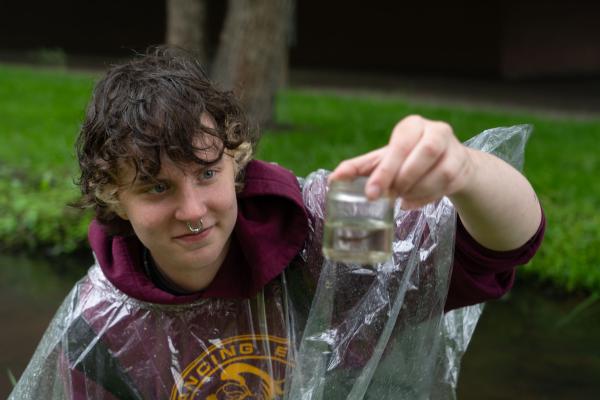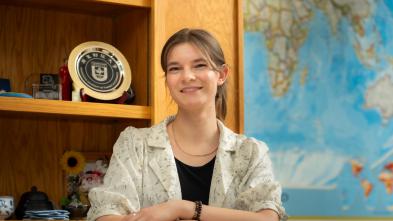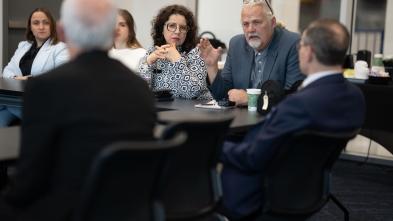“I wasn’t sure what to expect, to be honest,” says Gries, a hydrogeology major with a minor in chemistry.
“But the program has been fantastic. Learning new skills with students from other schools and other majors, from faculty with such a variety of backgrounds, is something that can never be replicated in regular coursework.”
Gries’ reaction at the end of the session is exactly what the course creator and funding agency had in mind.
Innovative state initiative sponsors unique opportunities at UW-Eau Claire
For the fifth summer since it was formed in 2019, the Freshwater Collaborative of Wisconsin has sponsored field study opportunities that include summer sessions at UW-Eau Claire.
The FCW is a statewide initiative that aims to harness the power of the 13 public state universities, along with partners from government, industry and local communities, to make Wisconsin a leader in water sciences and to educate young people about the state’s waterways and potential careers involving freshwater science.
Dr. Sarah Vitale, associate professor of geology and environmental science, is the principal investigator and collaborator on FCW grant-supported research and training opportunities hosted by UW-Eau Claire.
Over the last several weeks, Vitale and colleagues from UW-River Falls and UW-Stout offered a three-week field study course in hydrology, the study of water, its movement and interactions with the environment. Students from a variety of majors spent five days on each of the three campuses, learning skills and techniques from faculty across disciplines and subspecialties of freshwater science.
Building technology skills in water study
For their first full day on the UW-Eau Claire campus, students in the hydrogeology course spent a full day learning about geographic information systems and remote sensing technologies. These are two geographic toolkits also used in the investigation of freshwater systems.
The GIS day was taught by Dr. Zach Hilgendorf, assistant professor of geography and anthropology.
“Students examined historic aerial imagery and learned to interpret it to answer scientific questions, like how rivers have migrated over time, how reservoirs have grown or shrunk, and how we can calculate sediment erosion and deposition through time,” he says.
Hilgendorf says that FCW courses like Vitale’s hydrology field study are pivotal opportunities for students.
“The Freshwater Collaborative course is a truly formative experience, exposing students to an array of expertise,” he says. “From learning techniques in the investigations of wells to water quality monitoring, wetland delineation and historic aerial image interpretation, students gain new skills and learn to investigate the world of freshwater science through a multitude of lenses.”
Students cross campuses and majors to learn together
While the focus of instruction varied on each of the three campuses, the third week at UW-Eau Claire turned student focus to an independent research project of their choosing.
“As long as they were able to clearly state their research question and conduct the data collection and analysis on campus using technology and instruments available, they were open to choose any topic that interested them,” Vitale says.
For Gries, the science building construction site posed a question she was interested in answering.
“I chose to investigate the impact of the construction on the water quality in Little Niagara Creek,” says Gries, a native of Grafton.
The method Gries chose to employ was to collect water and soil samples upstream from the site, directly at the site and then downstream near the river.
“Our sample collection day was heavy rain, so it seemed that if the construction was negatively affecting the health of the creek, that evidence would be especially clear with the runoff on a rainy day,” she says.
In addition to the challenge of doing solo study, Gries says that she enjoyed the chance to use techniques and instruments she had not used previously, such as:
- A turbidimeter, which measures the presence of suspended sediments in water.
- Nitrate testing kit, which would show fertilizers or other waste material runoff from the site.
- Total suspension of solids testing. Particles like clay and silt will never settle in the water; they remain suspended, and construction can cause these particles to flush into streams at higher rates.




